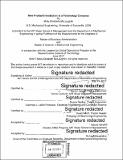| dc.contributor.advisor | Steven Spear and Duane Boning. | en_US |
| dc.contributor.author | McLaughlin, Molly Elizabeth | en_US |
| dc.contributor.other | Leaders for Global Operations Program. | en_US |
| dc.date.accessioned | 2017-09-15T15:37:06Z | |
| dc.date.available | 2017-09-15T15:37:06Z | |
| dc.date.copyright | 2017 | en_US |
| dc.date.issued | 2017 | en_US |
| dc.identifier.uri | http://hdl.handle.net/1721.1/111504 | |
| dc.description | Thesis: M.B.A., Massachusetts Institute of Technology, Sloan School of Management, in conjunction with the Leaders for Global Operations Program at MIT, 2017. | en_US |
| dc.description | Thesis: S.M., Massachusetts Institute of Technology, Department of Mechanical Engineering, in conjunction with the Leaders for Global Operations Program at MIT, 2017. | en_US |
| dc.description | Cataloged from PDF version of thesis. | en_US |
| dc.description | Includes bibliographical references (pages 83-85). | en_US |
| dc.description.abstract | Company X is a defense contractor that has built its competitive advantage on superior product performance. Over the last 10 years, government contracts have been changing to include stricter manufacturing and cost requirements. With these changes, design engineers can no longer design the most technologically advanced product and then hand it off to manufacturing engineers to figure out how to build it. Design and manufacturing engineers must work together to design the product to meet the contract performance, cost, and manufacturing requirements. It is difficult to balance the need to create a new technology that performs and the need to develop a product that can be easily produced. There is an added contextual factor. Because Company X is a defense contractor, it must follow special requirements and guidelines to satisfy their customer. These requirements typically add time and cost to a program. Many of Company X's programs are funded by the government, which means Company X's process is dependent on what process steps the government will fund. These steps can change from program to program. Because of the variability between programs, Company X's product development process is tailorable to meet the needs of each individual program. The goal of this research is to determine the best methods to better integrate manufacturing and cost requirements into the product development process to ensure that high technology businesses like Company X can keep their technology-based competitive edge in the market while also meeting more demanding cost and manufacturing requirements. The research is divided into five parts. First, existing literature on high performing teams, product development, and design for manufacturing is studied to determine best practices. Next, two internal case studies are performed to characterize the current state at Company X. Then Toyota's product development process is studied to learn best practices from another company known for developing high performing products that are also producible. After that, a gap analysis is completed to determine where the organizational gaps and process gaps at Company X exist compared to the best practices found in the literature review, within Company X, and in the Toyota case study. In order to ensure that recommendations are viable at Company X, a cause and effect analysis of best practices is also performed. The research ends with recommendations and conclusions for Company X to improve their product development process. The case studies show organizational and contractual difficulties with balancing cost, performance, and producibility. Company X puts a strong emphasis on product performance with their goals and incentives, and there is a strong design engineering culture. The organizational structure at Company X and the funding provided by the government on contracts do not always allow design and manufacturing engineering to work together early in the development process. The two programs studied made an effort to bring manufacturing and cost requirements into the product development process early. They started with a focus on balancing cost, producibility, and performance, but as issues arose, the focus shifted to performance. The development cycle is so long at Company X that the people who start a program are not responsible to finish it. There are also separate development and production teams with no real feedback loop to share issues and lessons learned. In order to improve these organizational and contractual issues, five recommendations are made to Company X. These include: implementing true integrated product teams (IPTs), simulating Toyota's chief engineer position using goals and incentives, incorporating playbooks/checklists into the development process, applying AS6500 requirements to all programs, and developing a closed loop system for producibility efforts. Implementing these recommendations is expected to provide better quality products that are easier and more affordable to produce. These recommendations are also expected to provide faster development cycles, higher morale, fewer cost overruns, fewer schedule overruns, and better integrated products. | en_US |
| dc.description.statementofresponsibility | by Molly Elizabeth McLaughlin. | en_US |
| dc.format.extent | 86 pages | en_US |
| dc.language.iso | eng | en_US |
| dc.publisher | Massachusetts Institute of Technology | en_US |
| dc.rights | MIT theses are protected by copyright. They may be viewed, downloaded, or printed from this source but further reproduction or distribution in any format is prohibited without written permission. | en_US |
| dc.rights.uri | http://dspace.mit.edu/handle/1721.1/7582 | en_US |
| dc.subject | Sloan School of Management. | en_US |
| dc.subject | Mechanical Engineering. | en_US |
| dc.subject | Leaders for Global Operations Program. | en_US |
| dc.title | New product introduction at a technology company | en_US |
| dc.type | Thesis | en_US |
| dc.description.degree | M.B.A. | en_US |
| dc.description.degree | S.M. | en_US |
| dc.contributor.department | Leaders for Global Operations Program at MIT | en_US |
| dc.contributor.department | Massachusetts Institute of Technology. Department of Mechanical Engineering | |
| dc.contributor.department | Sloan School of Management | |
| dc.identifier.oclc | 1003323618 | en_US |
